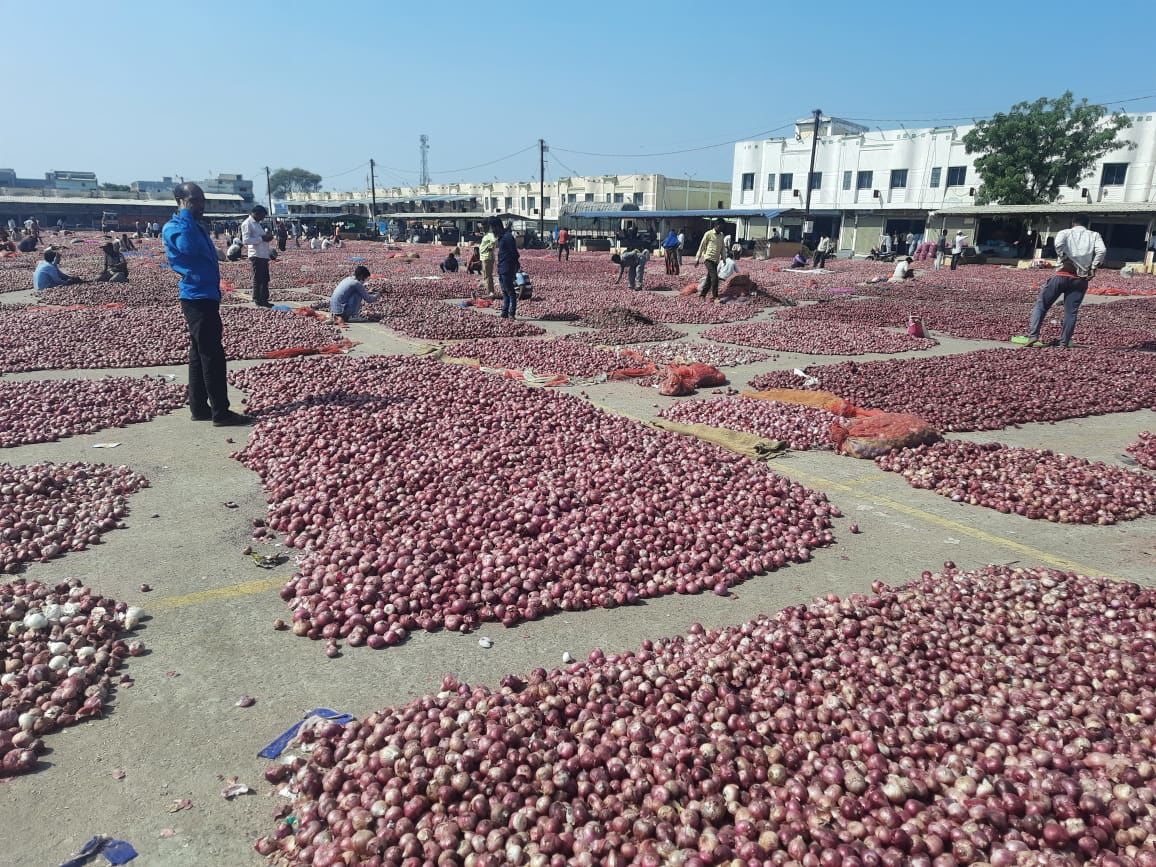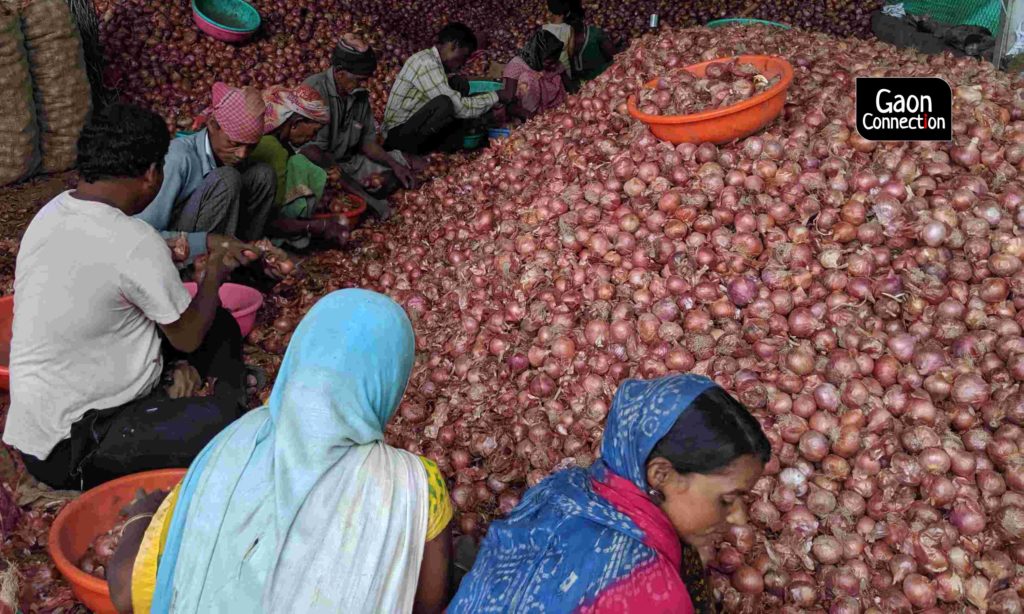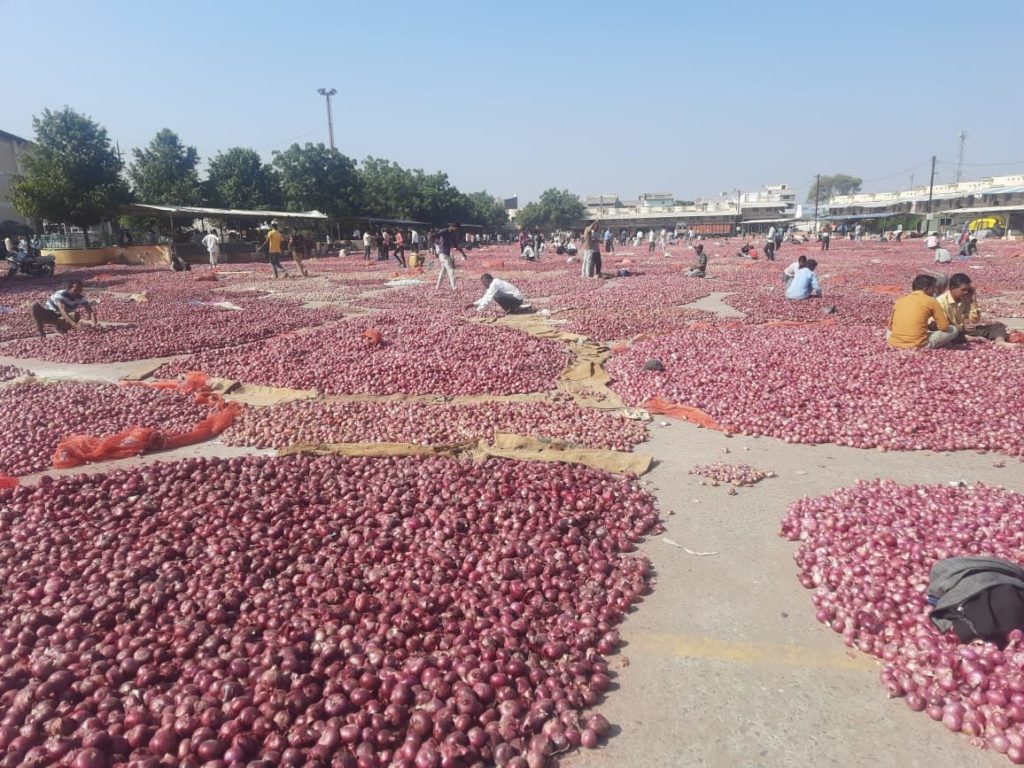Onion Tears: The price of onion might have come down, but is expected to climb steeply again
Heavy rains in September and October have ruined onion crop in Maharashtra, India’s top onion producing state. While farmers stare at huge losses, another steep rise in onion price is expected. A Gaon Connection report from Nashik, Maharashtra.

Nashik, Maharashtra
Even as onion prices take a breather in many retail markets across the country, coming down from Rs 100 a kilogramme (kg) in October to about Rs 80 in the second week of November, prices are expected to rise this winter.
The first kharif crop, which is sown in June-July and usually hits the market from October, suffered heavy damage due to rains in Maharashtra in September and October while the late kharif crop, which usually hits markets from January, will be delayed due to late planting. With only a small quantity of onions being imported, supply may not meet demand, placing neither consumers nor farmers at any advantage.
Maharashtra is India’s top onion producing state accounting for one-third of the total annual onion production of 16 million tonnes. More than 100,000 hectares is under onion production in Nashik alone. Lasalgaon in Nashik is the biggest onion market in Asia.
There are three types of onion crop — rabi (sown in December-January, harvested after March; called summer onion), kharif (sown in June-July, harvested after October), and late kharif (sown in September, harvested after December). The rabi crop has the least moisture content and can be stored for long. All these crops have been badly affected this year.
Sunil Pagar, an onion farmer from village Utrane in Satana taluka of Nashik has already lost his first kharif crop sown over two acres (0.8 hectares) due to heavy rains in September and October. “My summer onion started rotting in June, and I sold it for around eight hundred rupees a quintal in July. I did not benefit from the increased rates at all. Now my red onion crop is gone. I will be planting a late kharif on two acres to harvest in January. I’ve lost three lakh rupees,” Pagar told Gaon Connection.
Babasaheb Gujar, Nashik district president of Shetkari Sanghatna, an organisation of farmers, said, “Heavy rains have caused loss of seeds and crop. People will experience an extreme deficit of onions, and there is very little chance of prices falling. Many farmers are getting just two to three tonnes of kharif harvest an acre [0.4 hectares] in fields where they once got 12-13 tonnes.”
Also, the stored summer crop is almost over, and, so far, only a limited quantity of red kharif onion from Maharashtra has come to the market. Prices might increase after Diwali, Gujar explained.
Tushar Nikam, an onion farmer from Deola taluka in Nashik warned that as demand increases, onion prices will skyrocket till January. Nikam’s farm produces 2,500 to 3,000 quintals of onion every year. He had set aside around half of that to be sold around this time of the year, but only 50-60 tonnes remain; the rest [about 1,400 quintals] have been spoilt.
This happened despite the farmer sorting the stored onion to minimise rotting. “We have lost a lot of seeds this year as well due to rains. I usually require twenty five to thirty kilos of seeds, but I had to sow twice,” Nikam said.
Nikam is doubtful he will be able to recover his investment. “We depend on proceeds from one crop for the capital of the next crop. I won’t get a new loan from the bank till I pay my earlier loan,” he said.

Pitfalls of excess rainfall
Since rabi crop (summer onion) of onion has less moisture, farmers usually set aside a portion of this harvest for seed production in nurseries. In Maharashtra, onion (called kanda) is stored in structures called kanda chawls. The stored summer onions usually see 20 to 30 per cent losses. Unseasonal rainfall in Nashik in March-April, just when the harvest was to go into storage, resulted in nearly 50 per cent losses.
Also, since onions fetched high rates last year, many farmers sold their entire harvest. Even those who did set aside onions for seeds saw large quantities of seedlings destroyed due to heavy rains.
Farmers in Nashik said this compelled them to buy seeds from private companies or in the black market at high rates. But, these seeds did not germinate well.
Apart from Maharashtra, even Karnataka’s onion crop has suffered huge losses. Former’s kharif crop, the moisture-rich red onion, arrives in the markets by the end of October. Until then, the kharif crop from Karnataka meets the country’s demands. However, this year, heavy rainfall in Karnataka as well as Maharashtra affected both kharif crops.
Some farmers had to invest twice in seedlings due to the rains. This affected production of red onion — both in terms of quantity and well as the growth and harvest schedule. A spoilt rabi and kharif crop as well as a delay in the late kharif crop led to poor supply in face of rising demand, driving up onion prices in India.

Stock limits and attendant issues
Earlier this year, agriculturalists had rejoiced after the government amended the Essential Commodities Act, 1955, and brought in a new central act called The Essential Commodities (Amendment) Act, 2020, to exclude onions, potatoes, edible oils pulses from the list, thereby, freeing them from stock limits. But the three months of August, September and October saw a sudden spike in onion prices — in many cities, it touched Rs 100 a kg in retail markets.
According to data available on the Department of Consumer Affairs’ website, on August 6, the average retail onion prices in India was Rs 21 a kg. On November 6, it stood at Rs 63 a kg, a variation of 194 per cent in three months. Wholesale onion prices during the same period went from Rs 1,610 a quintal (100 kg) to Rs 5,462 a quintal, a 239 per cent increase.
The central government re-imposed a stock limit on onions on October 23. Wholesale traders are allowed to store only 25 tonnes of onion, while retailers can only store two tonnes.
Jaydutt Holkar, former chairman of Lasalgaon APMC (Agriculture Produce Market Committee) said that the Centre is only allowing and banning exports but it is not looking at controlling the blackmarket in seeds. “In March, onions were selling for five or six hundred rupees a quintal, and now when the rate is good, there are no onions to sell,” said Holkar.
He stressed the storage warehouses need to be improved. “This year, half the stock went bad in the kanda chawls. We need to figure a way to store the summer crop better. If the losses are fifty per cent, even if we sell onion at four thousand a quintal, it effectively means we get only two thousand rupees,” he added.
According to him, farmers were expecting at least Rs 6,000 a quintal. “If the low prices continue, farmers will not store any onion and sell off the summer harvest when it is ready. Storage takes time, effort and money. If we do that, in the winters, you have to pay up to one hundred and fifty rupees for a kilo of onion.”
Brief respite
While the central government re-imposed a stock limit on onions on October 23, it had already banned onion exports on September 14. It released 100,000 tonnes of onion from the buffer stock and invited bids for import of 15,000 tonnes of onion from other countries. About 7,000 tonnes have already arrived from countries such as Iran and Egypt. Besides, income tax raids were conducted on traders in Nashik, to stop hoarding.
These measures, coupled with moderate arrival of red kharif onion in the market led to a slight decline in onion prices in most Indian cities by the end of October. The average daily wholesale onion price in Mumbai as on November 12 was Rs 4,500 a quintal. The same was Rs 4,700 in Nagpur, Rs 2,900 in Pune and Rs 3,667 in Nashik. On the same date, the average daily retail price of onion in Mumbai was Rs 72 a kg and Rs 62 in Nashik. But prices are not expected to drop further.
It is not just consumers who are unhappy. Beaten down by the vagaries of weather and large scale crop destruction, onion farmers were hoping to break even when prices increased. With prices now declining, their hopes are dashed. As prices started crashing after the imposition of stock limit, and following the income tax raids, Nashik traders suspended onion auction for several days towards the end of October.
It was only after Maharashtra Chief Minister Uddhav Thackeray wrote to the Centre on October 30, urging the latter to increase the upper limit of onion stock upto 1,500 tonnes that the auction resumed. After auction started, on the first day, the summer onion crop fetched upto Rs 7,200 a quintal, but prices have dropped since then. On November 4, summer onion in Lasalgaon was sold at Rs 3,400 a quintal average while red kharif crop was priced at Rs 3,100 a quintal on an average. In Pimpalgaon Baswant, the rates were Rs 3,751 a quintal and Rs 3,500 a quintal, respectively. This, when farmers needed at least Rs 5,000 a quintal to break even.
Mahendra Hire of Tehre village in Malegaon taluka in Nashik has to pay back a loan of Rs three lakh that he took from a private finance company. “I sold 12 quintals of my summer onion crop and have 50 quintals more. I will sell it for whatever price I get now. This year, production has come down by seventy five per cent. And so, only five thousand rupees a quintal will help us break even,” he told Gaon Connection. “The quality of seeds was also very poor this time. Only thirty per cent of stored onion remains with farmers now. When we realised the onion was rotting, we wanted to sell it, but Corona lockdown meant no transportation,” he added.
Deepak Chavhan, an independent commodities expert, said that farmers are very vulnerable now. “Onion has never seen such weather disturbances, and farmers have to plant other crops too and not depend just on onion,” he told Gaon Connection. “India will have less supply as compared to demand until March. Consumers can expect rates in the region of forty to eighty rupees a kilo in the retail market until then,” he added.

